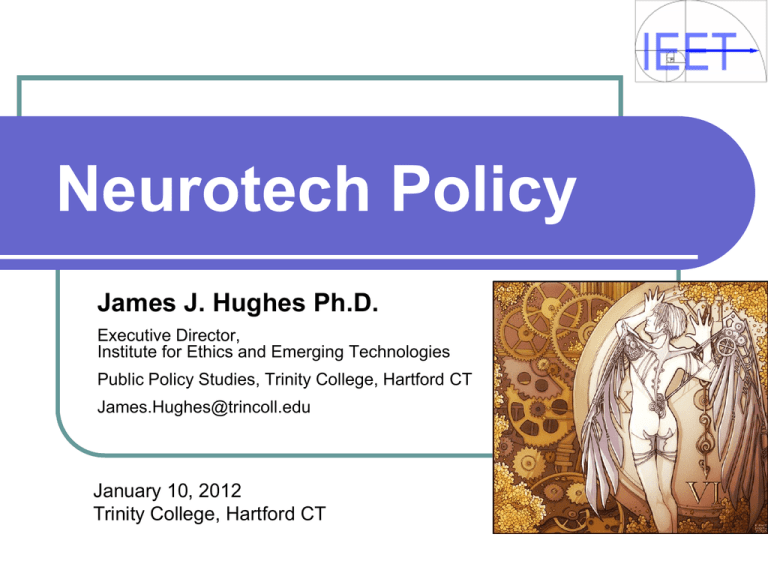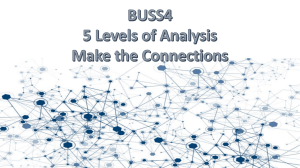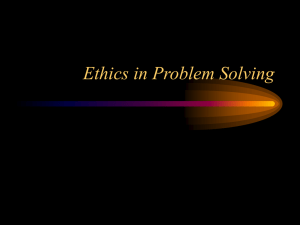Prosthetic Ethics - Institute for Ethics and Emerging Technologies
advertisement

Neurotech Policy James J. Hughes Ph.D. Executive Director, Institute for Ethics and Emerging Technologies Public Policy Studies, Trinity College, Hartford CT James.Hughes@trincoll.edu January 10, 2012 Trinity College, Hartford CT Broad Frame for Neurotech Hardware Internal External Institute for Ethics and Emerging Technologies Software External Hardware Pictures, written language and numbers outsourced the brain Started with clay and paper Today wearable computers Smart phones Aug cog The wireless exo-cortex Institute for Ethics and Emerging Technologies External Software Communication with other people: verbal, electronic Collaborative knowledge: Meetings, Markets, Wikipedia, Google Calendars & To do lists Info visualization Biofeedback Expert systems and intelligent agents Institute for Ethics and Emerging Technologies Internal Hardware Nutritional supplements Clinical drugs Stem cells and tissue engineering Deep brain stimulation Gene therapies Brain-computer interfaces Transcranial magnetic stimulation Nanorobotics Institute for Ethics and Emerging Technologies Countervailing Influences Consumer Lobbies Medical Associations (AMA, etc) Thinktanks (Brookings, AEI, Cato, etc.) Science Policy Industry Lobbies (Phrma, NIO, etc) Experts (NAS, etc.) Copyright Institute for Ethics and Emerging Technologies 2005 Points of Influence NIH/NIMH funding of basic research FDA Clinical Trials Development of Standards of Care DEA/criminal control of offlabel use and illegal drugs Public Insurance Coverage Private investment Product Development Private Insurance Coverage Institute for Ethics and Emerging Technologies 2012 Post Approval Surveillance and Research Pro-Science Citizen Lobbies Disease lobbies Stem cell research lobby groups State stem cell funding campaigns Consumer protection groups JDRF, ACT-UP, Alzheimers Critiquing politicized science policy Anti-psychiatry groups Mental patients rights, Aspie rights, Scientology Copyright Institute for Ethics and Emerging Technologies 2005 Neuroprosthetics & NNI NIH Neural Prosthesis Program Cochlear & retinal implants Peripheral neural prosthetics Brain implants National Nanotechnology Program Ethical, Legal and Other Societal Issues Institute for Ethics and Emerging Technologies 2012 Prosthetic Limbs Indirect neural control Direct neural control Haptic feedback Institute for Ethics and Emerging Technologies 2012 NBIC Convergence Nano-Bio-Info-Cogno Program (2003-) Psychopharmacology Genetic engineering Nanotechnology Artificial intelligence Cognitive science The accelerating convergence of all these for “enhancing human performance” Institute for Ethics and Emerging Technologies 2012 Cognos and Brain Modeling Modeling brain systems and cognitive processes will allow rapid testing of neurotechnology Blue Brain Project (IBM, Swiss) Cognos Project Finetuning of evolving exocerebrum against models of the neocortex Institute for Ethics and Emerging Technologies 2011 Tissue Engineering Stem cells engineered into therapeutic neural tissue Nanomaterials as scaffolding and mesh around which stem cells can grow tissues and neural bridges Using electrical stimulation of cells through the mesh to control the growth of the tissue Institute for Ethics and Emerging Technologies 2012 Deep Brain Stimulation Depression Obsessive-compulsive disorder 1% of the population has seizure disorders, such as Epilepsy Parkinsons Disease Institute for Ethics and Emerging Technologies 2012 Cochlear and Visual Implants By 2010, approximately 219,000 people worldwide received cochlear implants. In US, 42,600 adults and 28,400 children received them. Institute for Ethics and Emerging Technologies 2012 Brain Damage & Neuroprosthetics Post-stroke brain injury is leading cause of disability in U.S. One in 250 suffer from the effects of head injuries About 750,000 people with cerebral palsy in the U.S. About 75,000 quadriplegics in the U.S. Lou Gehrig's Disease or ALS and muscular dystrophy each effects about 15,000 Americans “Locked-in state” Neuro-regenerative Rx Neuroprosthetics Institute for Ethics and Emerging Technologies 2012 Brain-Computer Interfaces Institute for Ethics and Emerging Technologies 2012 NanoNeural Robotics Ray Kurzweil 2030s? Self-replicating Two-way communication with trillions of neurons Networked inside and out Perfect virtual reality, mind back-up, upload Institute for Ethics and Emerging Technologies 2012 Non-Problems & Old Problems Some ethical issues are false problems, at least from an Enlightenment POV Others are old problems, like ensuring safety and access A few are novel because of the efficacy of neuroprosthetics Institute for Ethics and Emerging Technologies 2012 Non-Problems Supersoldiers Sports enhancement Disappearing disabled cultures Authenticity Institute for Ethics and Emerging Technologies 2012 SuperSoldiers Ethics of military force, or of military applications Does neurotech change likelihood of exploiting soldiers as guinea pigs or in the field ability to exercise judgment in field, reduce collateral damage (drones) likelihood of engaging in conflicts Institute for Ethics and Emerging Technologies 2012 Sports Enhancement ADD drugs? Sports is a rulegoverned game If athletes want to use neurotechnology to compete they can start their own leagues Not relevant to society Institute for Ethics and Emerging Technologies 2012 Disappearing Disabilities 99% of disabled happy to give up their disabilities Only children forced to use Last century: dramatic decline in veteran and civilian amputees 1000 amputees from Iraq/Afghan vets 1000+ surgeons in Civil War, 60,000+ amputees Changes cost-benefit analysis for social priority-setting (Loeb) Difficulty in commercializing the direct neural control prosthethics developed by DARPA or others Institute for Ethics and Emerging Technologies 2012 “Authenticity” Avoidance of SSRIs, ADD drugs Not human, not me But Self image is malleable Prosthetics easily incorporated Institute for Ethics and Emerging Technologies 2012 Old Problems Safety of devices Autonomy and addiction Moving line between disability/normal/ enhanced Unequal access Ownership & intellectual property Privacy & cybersecurity Institute for Ethics and Emerging Technologies 2012 Safety Federal Food, Drug, and Cosmetic Act covers all implants and other devices "intended to affect the structure or any function of the body of man or other animals“ But FDA’s 510k (similar to prior approval) loophole Center for Devices and Radiological Health underfunded to handle scope and pace of innovation Authority inadequate to gather clinical trial information or compel reporting of post-approval adverse events Are military IRBs’ reviews adequate to protect soldiers from experimental technologies Institute for Ethics and Emerging Technologies 2012 (Il)legal Psychoactive Drugs DEA has 5 categories of scheduled drugs, then over the counter Data Censoring by Investigators The aggregation of experimental outcomes by health systems Assure completeness of result reporting Copyright Institute for Ethics and Emerging Technologies 2005 Autonomy & Addiction Remote behavior control of criminals, soldiers, astronauts Wireheading: mood control Blurred culpability: developer, software, user Institute for Ethics and Emerging Technologies 2012 Home Health Monitoring Telemedicine Wireless devices, linked to health system Blood Pressure Monitors Glucometers Peak Flow Meters Pulse Oximeters Weight Scale Copyright Institute for Ethics and Emerging Technologies 2005 Defining Disabled/Enhanced When Medicare changed its definition for coverable cochlear implants from deafness to severe hearing loss it expanded coverage for millions of seniors Similar fights over Depression (transient grief) vs. mood enhancement Attention-deficit vs. performance enhancement Institute for Ethics and Emerging Technologies 2012 Superhuman Abilities 5% to 35% college students use off-label stimulants as study aids Institute for Ethics and Emerging Technologies 2012 Modafinil (Provigil) Developed and approved as treatment for narcolepsy and “excessive day-time sleepiness” Schedule 4 controlled substance Diagnostic Creation of ADD 1930s stimulants prescribed to treat “minimal brain dysfunction” 1960s “minimal brain dysfunction” “learning/behavioral disabilities” and “hyperactivity” Ritalin synthesized in 1950s, prescribed in 1960s DSM-II (1968): “Hyperkinetic Reaction of Childhood” DSM-III (1980): “ADD (Attention-Deficit Disorder) with or without hyperactivity” DSM-III-R (1987): “ADHD” ICD-10: “Hyperkinetic disorders” DSM-IV criteria diagnose 4x more ADHD than the stricter ICD-10 criteria Unequal Access In every other industrialized country the debate is what should be in or out of the plan Here it is up to 1500 private and 60 or so public insurance plans Critical: Speed of innovation of cheap versions Institute for Ethics and Emerging Technologies 2012 Ownership & Property Human gene patenting Pharmaceutical and neurodevice patent overreach Expansion of Chinese neurotech device production (e.g. Medtronic) International IP Protection Humanitarian exemption and pricing Institute for Ethics and Emerging Technologies 2012 International Harmonization Harmonization of regulation within the OECD (including Japan) will speed innovation Global Harmonization Task Force (Devices) International Conference on Harmonization (Drugs) Copyright Institute for Ethics and Emerging Technologies 2005 Privacy and Cybersecurity Already issue with mobile technology and RFID Privacy of biometric information controversy in 2002 over the VeriChip patient ID and tracking system Implanted medical records, e-cash, telecom Battlefield biotelemetry Wireless hacking of prosthetics (Jay Radcliffe: insulin pump hacking) Self-hacking to control drug administration Required registration of high-power prosthetics National security secrecy and corporate IP inhibit open source innovation, translation to application See: 2005 EU Report “Ethical Aspects of ICT Implants in the Human Body” Institute for Ethics and Emerging Technologies 2012 Newer Problems Timing of implants and upgradeability Structural unemployment Remote behavior control Mood control Blurred culpability Institute for Ethics and Emerging Technologies 2012 Timing of Implants Accelerating pace of innovation Especially rapid advances in biocompatible materials Cochlear implants Critical language window Destruction of cochlear tissue Institute for Ethics and Emerging Technologies 2012 Structural Unemployment Prior cases: literate/numerate workers Digital divide smartphones Competing not only against automation and globalization, but also against brain-machine enhanced workers (vets?) Cog enhancement drugs AugCog Institute for Ethics and Emerging Technologies 2012 Neuropolicy Organizations International Society for Neuroethics Dana Foundation MacArthur Foundation Network on Law and Neuroscience Center for Neurotechnology Studies, Potomac Institute for Policy Studies in Arlington, Virginia Neurotechnology Industry Organization Institute for Ethics and Emerging Technologies 2012 Neuropolicy Experts Walter Glannon, Philosophy, University of Calgary David Eagleman, Neuroscience, Baylor College of Medicine Jonathan Moreno, Center for American Progress Martha Farah, Upenn Center for Neuroscience and Society Hank Greely, Stanford Program in Neuroethics Judy Illes, Chair in Neuroethics, Univ of British Columbia Michael Gazzaniga, Cognitive Neuroscience, Dartmouth College Zach Lynch, Neurotechnology Industry Organization Diana Zuckerman, Alliance for a Stronger FDA Institute for Ethics and Emerging Technologies 2012 For more information Institute for Ethics and Emerging Technologies ieet.org Me: director@ieet.org These slides: http://ieet.org/archive/20120110-neurotechpolicy.ppt Institute for Ethics and Emerging Technologies 2012








